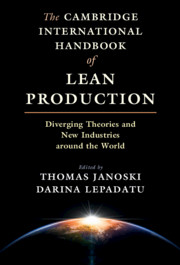 The Cambridge International Handbook of Lean Production
The Cambridge International Handbook of Lean Production Book contents
- The Cambridge International Handbook of Lean Production
- The Cambridge International Handbook of Lean Production
- Copyright page
- Dedication
- Contents
- Tables
- Figures and Sidebars
- Preface
- Acknowledgments
- Contributors
- Abbreviations
- 1 Lean Production as the Dominant Division of Labor
- Part I Theories of Lean Production
- 2 Lean Production from the View of Management Theory
- 3 Lean Production – Perspectives from its Primary Caretaker, Industrial Engineering
- 4 The Industrial Relations Perspective on Lean Systems, Workers, and Unions
- 5 Contested Views of Lean Production from the Social Sciences Perspective
- 6 The Lean Labor Process
- Part II Lean Production across Industries
- Part III Lean Production Around the World
- Name Index
- Subject Index
- References
5 - Contested Views of Lean Production from the Social Sciences Perspective
from Part I - Theories of Lean Production
Published online by Cambridge University Press: 11 March 2021
- The Cambridge International Handbook of Lean Production
- The Cambridge International Handbook of Lean Production
- Copyright page
- Dedication
- Contents
- Tables
- Figures and Sidebars
- Preface
- Acknowledgments
- Contributors
- Abbreviations
- 1 Lean Production as the Dominant Division of Labor
- Part I Theories of Lean Production
- 2 Lean Production from the View of Management Theory
- 3 Lean Production – Perspectives from its Primary Caretaker, Industrial Engineering
- 4 The Industrial Relations Perspective on Lean Systems, Workers, and Unions
- 5 Contested Views of Lean Production from the Social Sciences Perspective
- 6 The Lean Labor Process
- Part II Lean Production across Industries
- Part III Lean Production Around the World
- Name Index
- Subject Index
- References
Summary
The social sciences perspective on lean production is much less unified than the previous two areas of management and industrial engineering. Some studies of the impact of lean production on the workforce cover positive aspects such as teamwork, job rotation, job enrichment, and job satisfaction. Other studies examine the negative aspects such as work intensification, long and unannounced overtime, and the extensive use of temporary workers. Yet another group studies the diffusion of lean production, and there are alternative models like socio-technical theory and diversified quality production. As a result, this chapter focuses on six approaches to lean: (1) sociological studies of lean production; (2) socio-technical theory as a social psychological approach to lean and teamwork; (3) the diffusion of lean production; (4) critical social science and flexible accumulation; (5) the productive models approach; and (6) diversified quality production. The social sciences are more divided about the benefits and costs of lean production, so we start with the three positive views and follow with the three critical approaches.
- Type
- Chapter
- Information
- The Cambridge International Handbook of Lean ProductionDiverging Theories and New Industries around the World, pp. 124 - 149Publisher: Cambridge University PressPrint publication year: 2021


